Bathroom floor tiles: varieties and tips for choosing
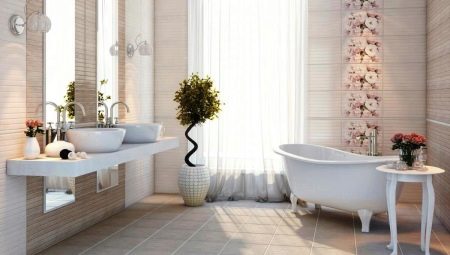
Tile has long been the most popular material for bathroom flooring. On the one hand, this is due to the fact that the tiles are distinguished by a wealth of design solutions. On the other hand, this is not just beautiful material. The tiles are characterized by special quality characteristics that are ideal for bathroom floors. You will learn more about how to create a beautiful interior using this material from the article.
Views
Tiles are often used to decorate flooring. There are many varieties of this material. Depending on the manufacturing technology, there are 2 types of floor tiles in the bathroom.
- Pressed - is made of plastic mass, which includes special additives and a binder. The mixture is poured into molds and pressed. Next, the finished products are sent for firing.
- Extruded - raw tiles are obtained by extruding a plastic mixture. Next, the workpieces are cut and fired, and then the glaze is applied.
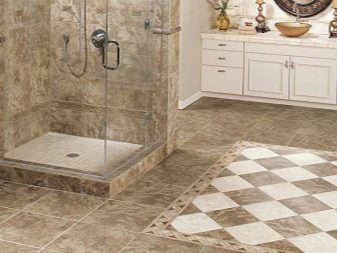
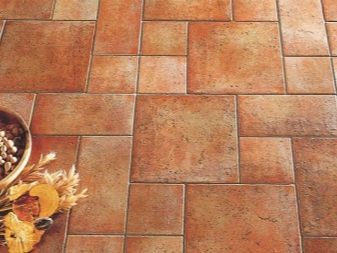
These two types of material are used for flooring, as both have suitable characteristics. However, extruded versions are more common on the market.
In addition to this classification, there is another one. Consider the main types of tile flooring.
- Porcelain stoneware. Porcelain stoneware is distinguished by its strength and durability, a variety of designs. Such models have a homogeneous structure, which in appearance resembles a glass surface.
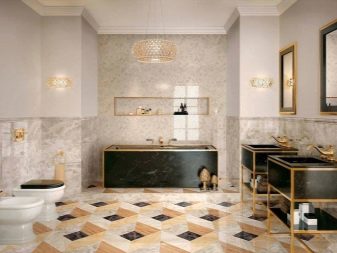

- Rubber. Such tiles are quite rare in the interior of the bathroom.However, it has good wear resistance and is ideal for the bathroom. These models are made from recycled rubber and assembled using special joints. Rubber tiles come in a wide variety of colors.

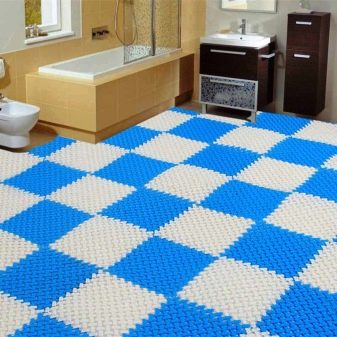
- Ceramic or tiled... It is one of the most widely used coatings with a long service life and attractive appearance. The tile is quite diverse in design options and is suitable for decorating premises in various stylistic directions.

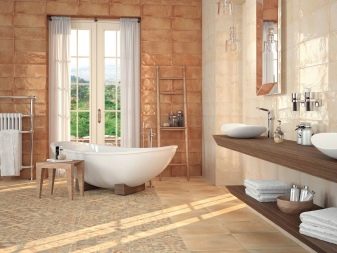
- Clinker room. This is a type of ceramic tile that has a rough surface and uneven joints. As a rule, such options have a natural color and classic design.
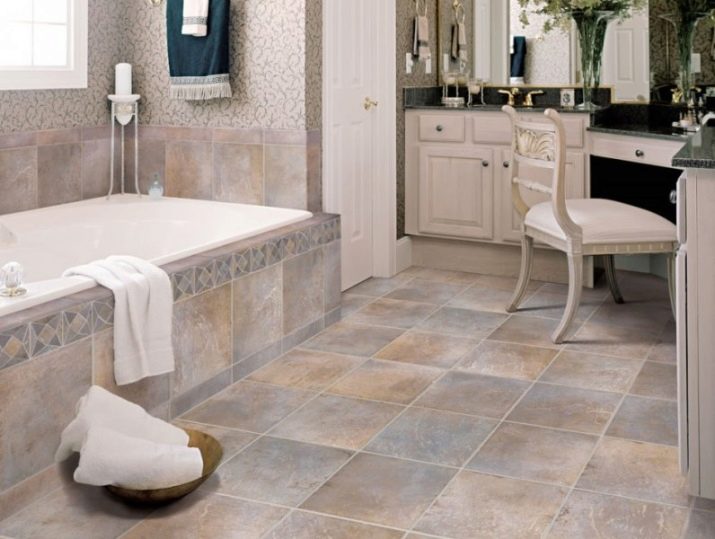
- Stone. Such models are made from natural or artificial stone. They always look noble and elegant.
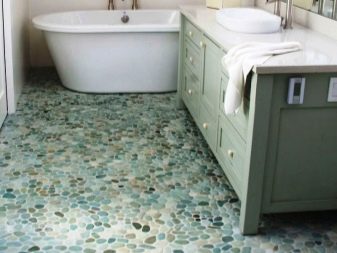
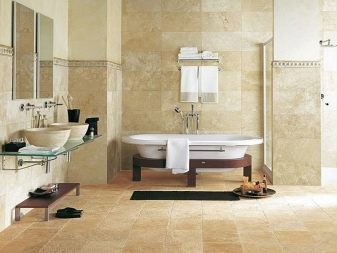
- Cotto. Such tiles are characterized by a porous surface, since they are not covered with glaze. Despite the low cost, such models are rarely used for bathroom decoration.

- Synthetic... This tile is made from PVC, it is characterized by wear resistance and low thermal conductivity. Therefore, it is not suitable for cold or poorly heated rooms.

- Quartz vinyl. This is an environmentally friendly thin tile. It is easy to install thanks to its adhesive backing.
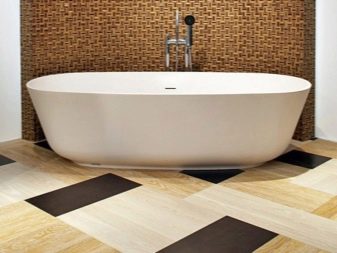

- Flexible. These are options from ceramics or natural stone. For its production, the latest technologies are used that allow you to preserve the original appearance of the material, but at the same time make it flexible. Flexible options withstand high temperatures well, which is why they are often used for underfloor heating. And the water resistance makes them popular for bathroom floors.
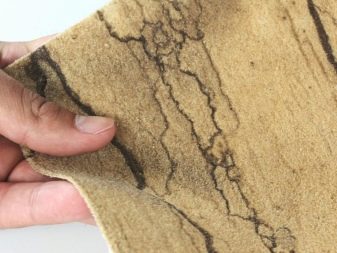
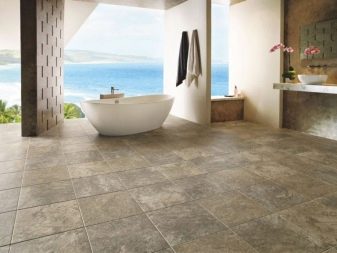
Dimensions (edit)
Floor tiles are available in various sizes. Moreover, it can be square, rectangular or irregular. Usually, floor models are available in sizes 10x10, 25x25, 30x30, 40x40, 50x50 and 60x60 cm. However, more and more variants of other sizes appear on the market, for example, 25x12.5 and 33x33 cm. The minimum flooring thickness is 0.9 cm, since thinner models do not have the required strength.
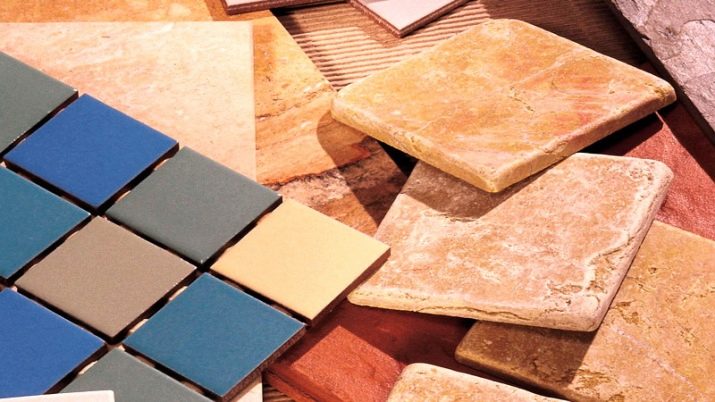
Thus, large tiles are the most demanded. This is due to the fact that the installation process is quite simple, which reduces the operating time. Moreover, the seams between the tiles can be made bright without the fear that the floor will look too colorful and clumsy.
Small and medium-sized tiles are equally common. Medium-sized options are better suited for small spaces as they do not visually constrict the space. Small tiles allow you to create an amazing mosaic that always looks relevant and stylish. However, the mosaic requires careful installation, which significantly increases the cost of installation work.
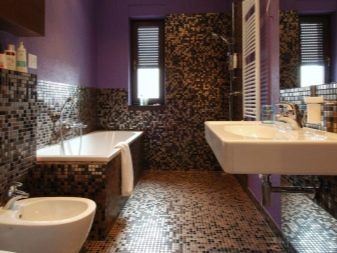

Color spectrum
The choice of colors is very important because colors have different effects on the psyche and mood of a person. However, it also depends on the personal preferences and taste of the person: for example, for one person bright yellow light may be associated with joy and warmth, but for another - it will become too bright and annoying.
In addition, colors affect the appearance of a room differently depending on its size or lighting.
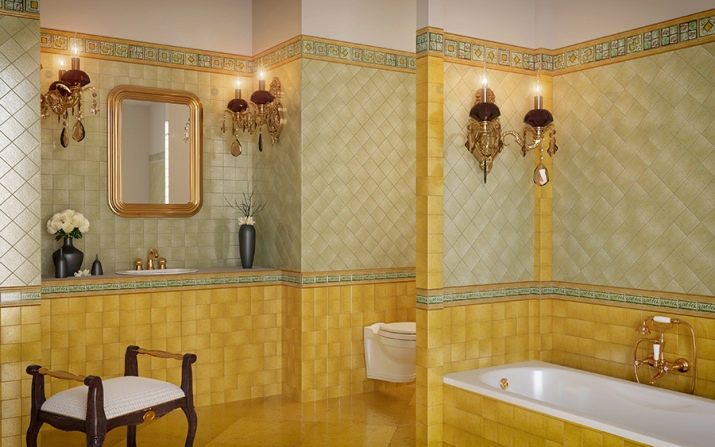
Black floor tiles it is rarely used as a floor covering, since any dirt, cracks and dust are clearly visible on it.
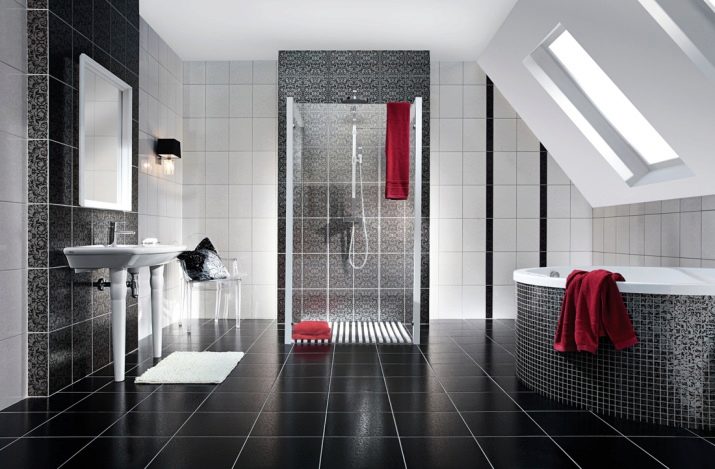
Beige tiles it is considered the best solution, since streaks are practically not visible on it. The beige color looks gentle and calm. It is used in almost all existing styles.
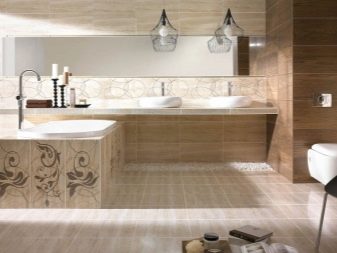
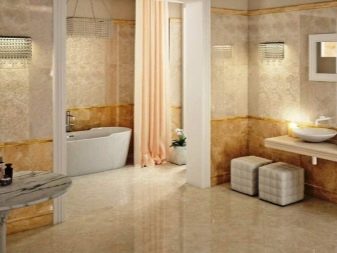
Green color will help to create a bright and cheerful interior. Green has a positive effect on mood. It goes well with other bright or neutral colors.
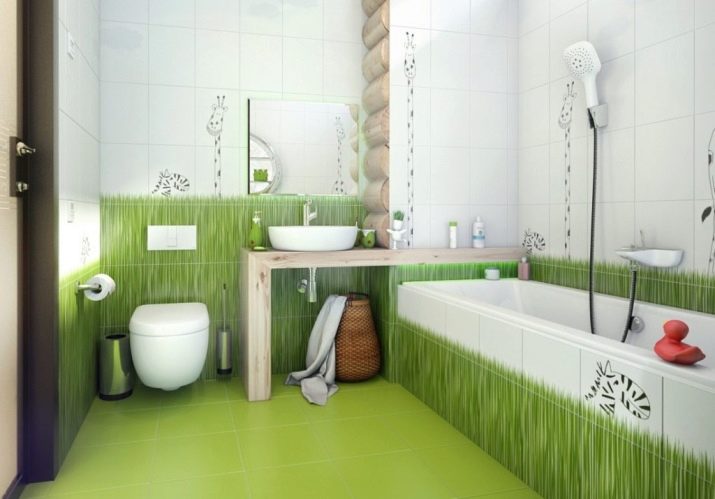
Grey colour Is a practical and discreet shade that, in fact, is universal.It can be used in any style as it goes well with a variety of colors.
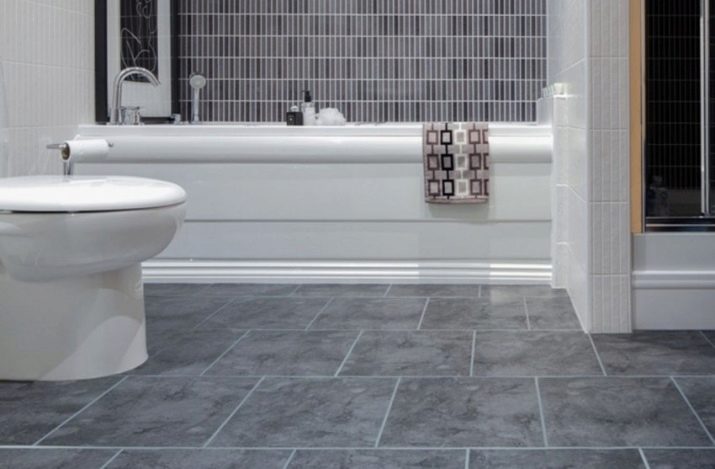
Brown shades always look noble and deep. You can use both the darkest shades and the lightest. A combination of several shades of brown always looks beautiful.
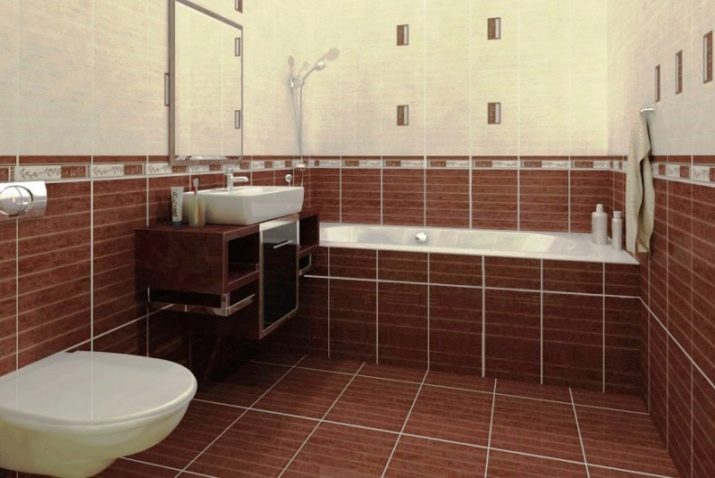
Red tile looks bright. She is chosen by brave personalities. This color is better suited for spacious bathrooms. Intense red goes well with white, gold, black or beige. However, other solutions are also possible.
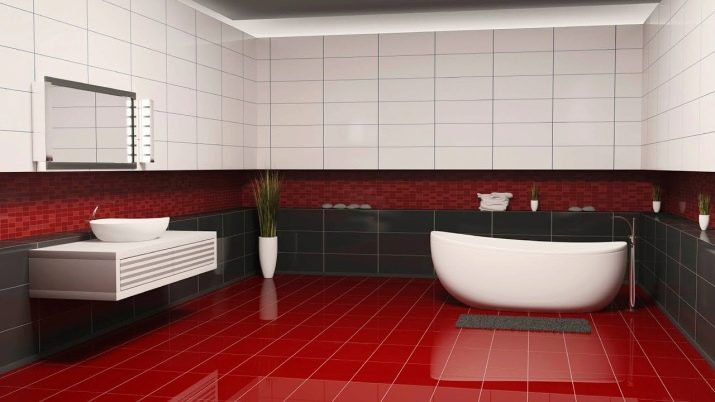
And here pink tile quite rare when decorating a bathroom. This color is often used to implement unusual design solutions.
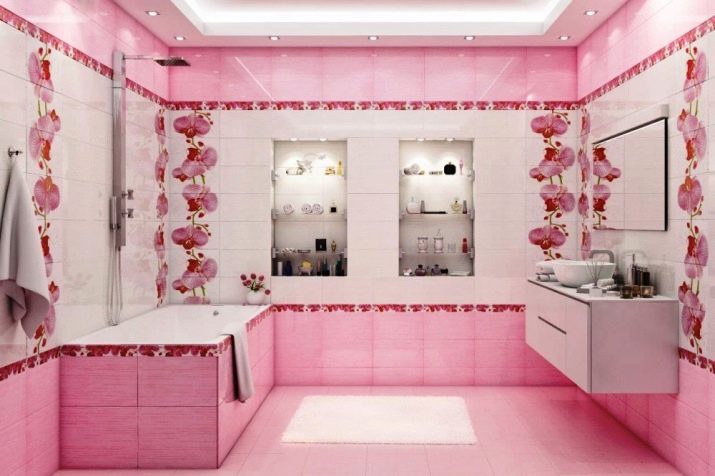
The floor looks beautiful, decorated with two contrasting colors. It can be a classic combination of white and black, or it can be a combination of red and black or black and gray.

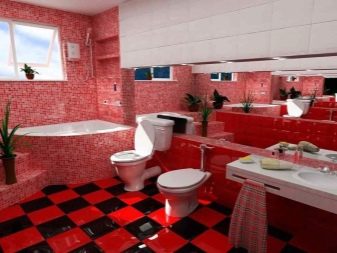
Design
As a rule, a monotonous coating looks monotonous and rather boring, and therefore quickly becomes boring. Solid color tiles are mainly used for design, where the main focus should be on walls or furniture. But for other design solutions, there are more non-standard tile design options.
Models with imitation of natural wood look unusual and interesting. The color can be either light brown or dark, almost black. It's important to know that wood grain looks best on darker surfaces.
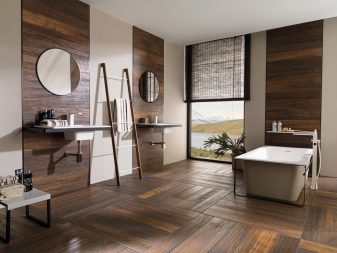
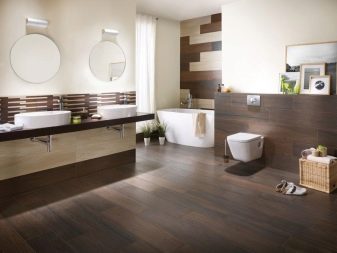
An unusual variety is stone tiles. Here, a wide variety of options are possible, from brickwork to marble texture.

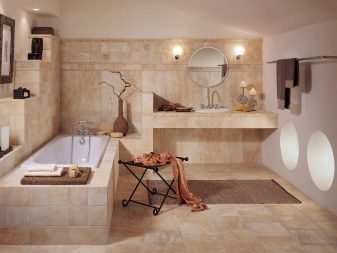
A special module can be laid out from a tile. For it, models of different shapes or with different patterns are used. Together they form an unusual pattern. These models can be used to decorate the entire floor or parts of it.
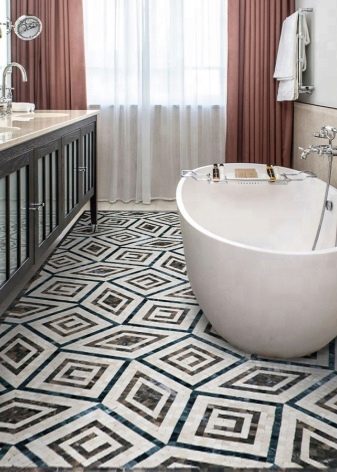

In addition, there is matte and glossy surfaces... Models with a matte surface require more careful maintenance, but they look more interesting and unusual. But the glossy texture always has an unusual shine, which makes the room visually wider and more spacious.

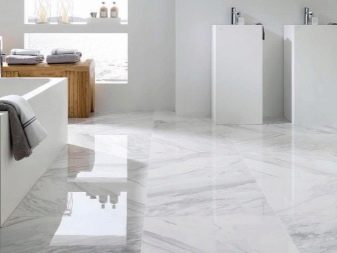
Looks original mosaic. It is created from tiles of the same size. To create a mosaic, you can use several shades of the same color or different colors.
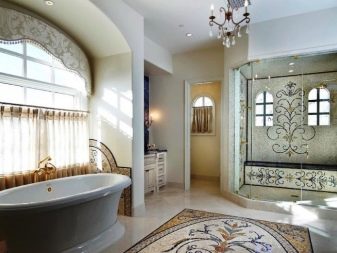

Tiles can be decorated various designs and patterns. According to designers, it is preferable to choose large patterns for flooring. The traditional solution is to use the same pattern for the entire floor. However, a combination of tiles with different patterns in the same color scheme will look more attractive and interesting.
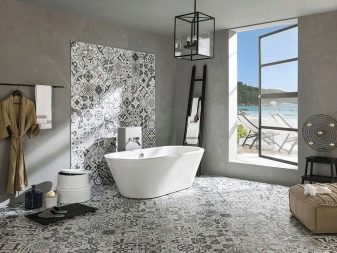
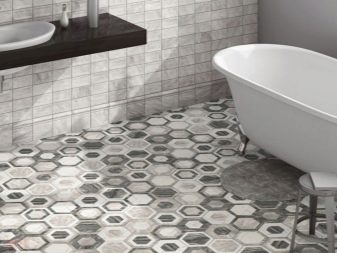
How to choose?
When choosing a tile, many turn their attention solely to its design. But this is a terrible mistake that can be worth the wasted nerves, time and money. It is important to carefully study the quality characteristics of the model you like.
As a rule, all important characteristics of a tile are applied to the packaging box as a special marking. For example, a palm on a black background indicates patterns for the walls, and on the feet, floor tiles.

When choosing, you should pay attention to a number of factors.
- Resistant to wear and tear. Ideally, the material for the floor should have an increased rate in order to last a decade and not lose its external properties. This requirement is due to the fact that various contaminants often appear on the bathroom floors, which are washed off with the help of rather aggressive chemical compounds. Moreover, various cosmetics, sprays and perfumes are often used in the bathroom.
- Resistant to acids and alkalis... This indicator is marked "A" and "AA". As a floor covering for a bathroom, it is better to choose options marked "AA".
- Strength... Floor tiles must be durable, otherwise cracks and potholes will appear on them.
- Non-slip surface. Particular attention should be paid to this characteristic, since the coating in the bathroom often becomes slippery as a result of the ingress of water or steam.
- Design... Of course, this factor is equally important, since the appearance of the bathroom depends on it. If you don't like the design, then you will never be able to completely relax in the bathroom.
- Floor material. It is necessary to take into account the material on which the tiles will be laid. It can be chipboard, concrete and other materials. All of them have their own distinctive properties, so there are different requirements for laying tiles on them.


Laying methods
In addition to different design options, there are several ways to install tiles.
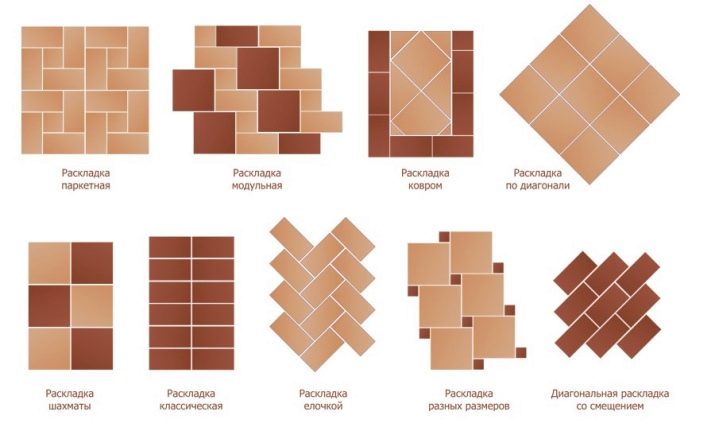
- Classical. This is the most common and easiest way. The tiles are laid in parallel rows. This method is used for square and rectangular options.
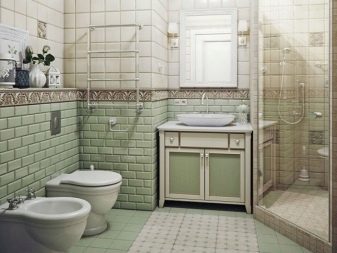

- Diagonally... This method is considered the most beautiful, but the installation process is quite complicated. This is due to the fact that it is necessary to correctly position the axles. The main advantage of this type is that it is able to hide all the unevenness of the floor and visually expand the space. For the diagonal method, more tiles will be required than for the classic version.
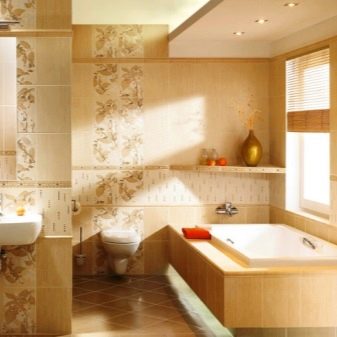
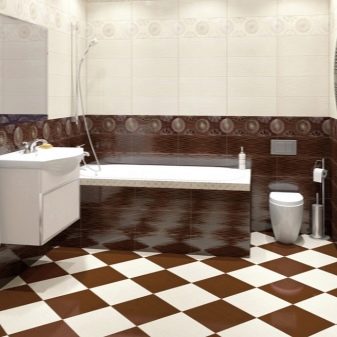
- Offset. This method has the same pattern as brickwork. Plain rectangular tiles are ideal for it. Although sometimes they use square options.
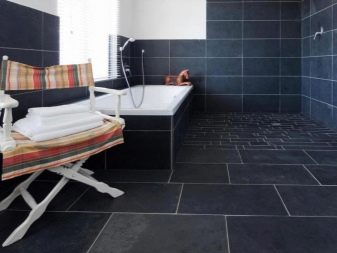
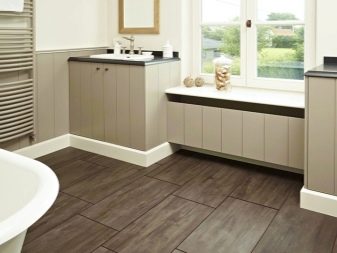
- Herringbone. Such masonry imitates parquet pattern. Small rectangular tiles are used for it. As for the color and pattern, these are, as a rule, monochromatic models of any color or shade. There are two options for this masonry. The first is the traditional herringbone. The second is a herringbone with attachment. It requires small square inserts. They can be the same color as the rectangular tiles, or they can be different. Models with imitation of natural wood are best suited for such masonry.
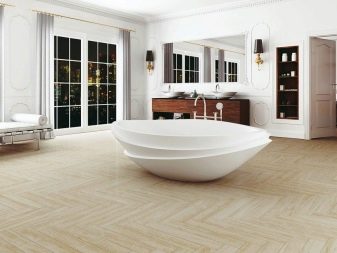
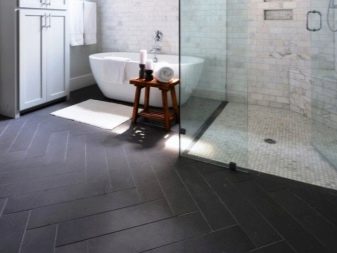
- With a shift. For stacking with a shift, square options are used in two sizes. Small tiles fit between large tiles, filling the free space. This method is similar to herringbone masonry with attachment.
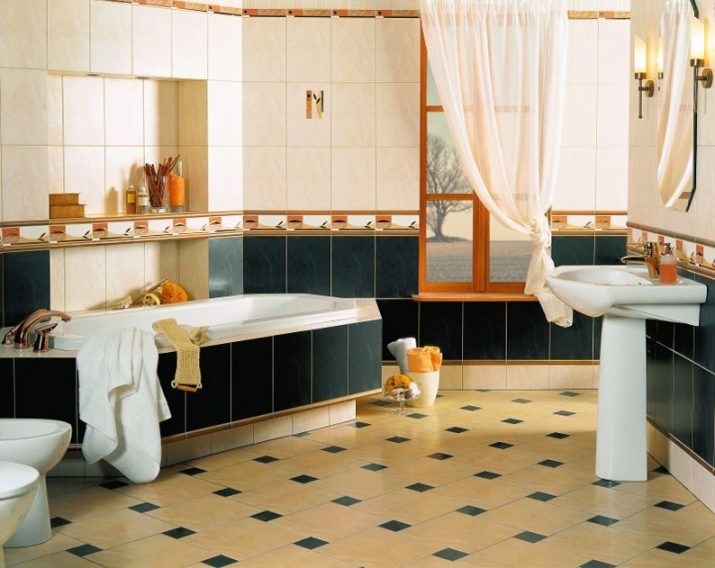
How to care?
In order for the tile not to deteriorate and to serve for many years, it needs careful and accurate care.
Do not wipe the tiles with a metal sponge, as it can damage the surface and leave scratches on the tiles. It is best to use a soft sponge or medium-hard brush to apply the detergent. And in order to remove it, you must use a damp cloth or another sponge.
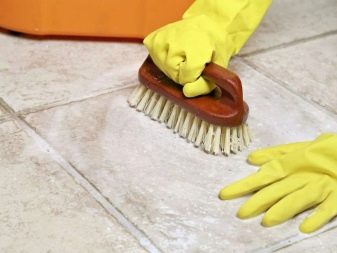
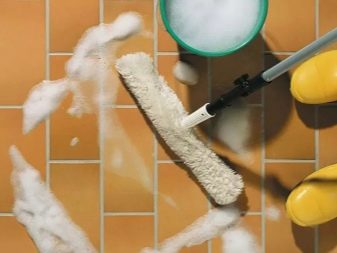
The second prohibition is the use of chlorine. This substance is quite aggressive on the surface. Moreover, under its influence, tiles can lose their color and shine. You can use any liquid detergent for the tile, even dishwashing detergent will do. Because it removes greasy stains well. From traditional means, you can use soda.

For tiles to shine, they must be constantly wiped with a microfiber cloth.
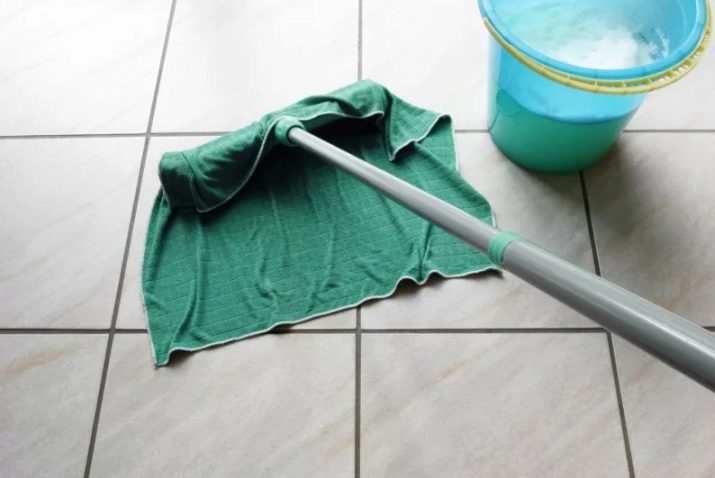
Beautiful examples in the interior
To decorate a classic interior, the use of a large module in the center is well suited. Delicate tiles in beige tones go well with brown designs.
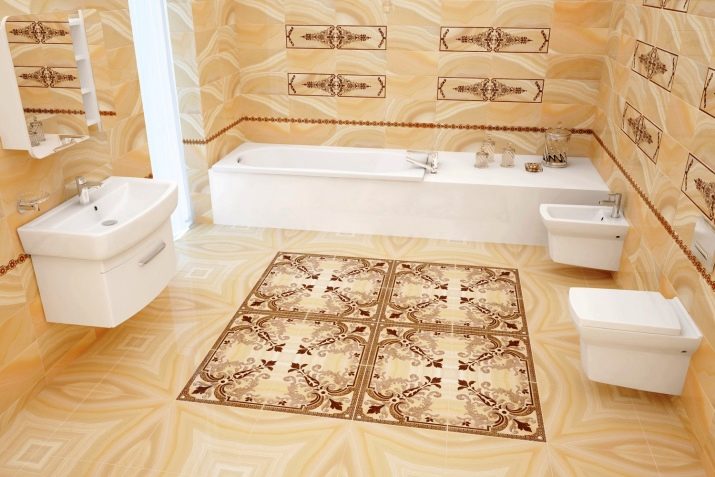
Imitation of natural wood looks noble and expensive. And herringbone masonry makes the interior more interesting.
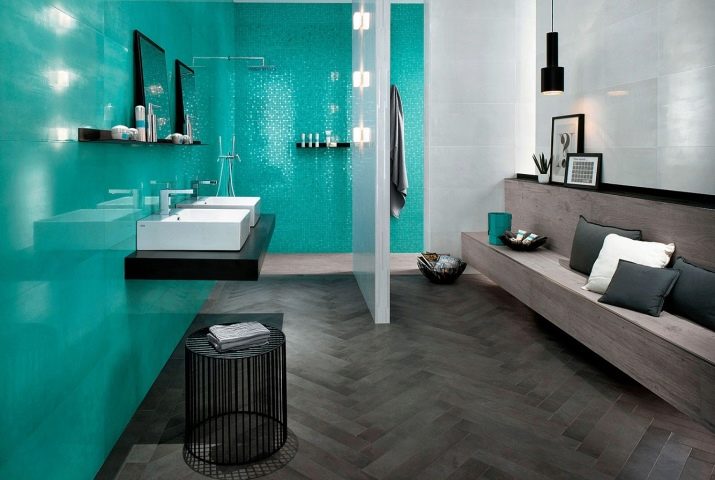
Diagonal black and white checkerboard masonry will perfectly complement the snow-white classic interior. And red accents will make the bathroom design more vibrant.

Large brown tiles look calm and noble. Since the room is divided into two zones using a small podium, two masonry methods can be used: classic and diagonal.

For a snow-white interior, the ideal solution would be white glossy tiles with an unusual design.
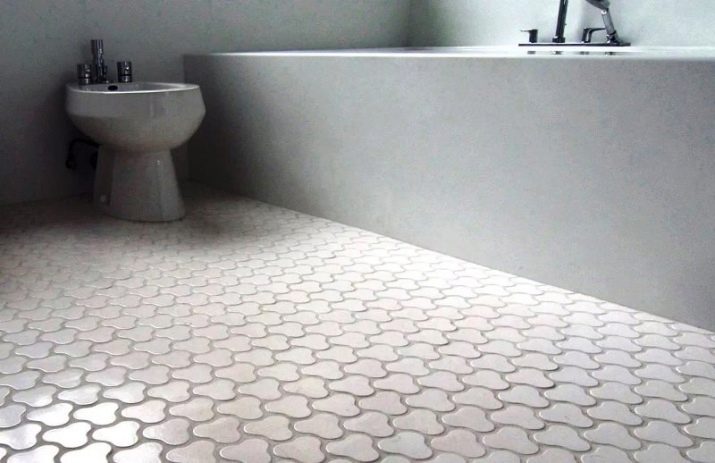
The combination of tiles with various patterns looks bright and stylish.
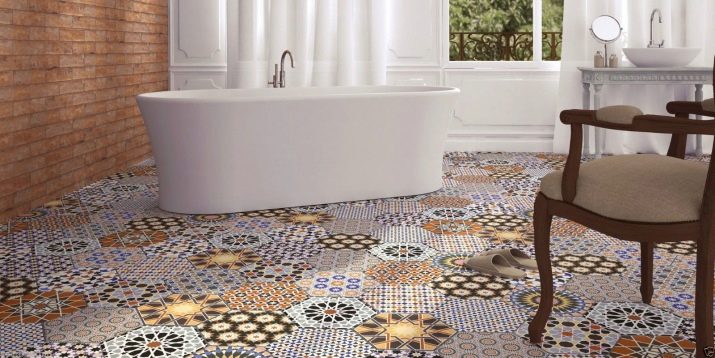
An interesting mosaic can be created from tiles of an unusual size.

By using beige and brown colors, you can create an imitation of a carpet runner. This will make the design more interesting and highlight important functional areas.
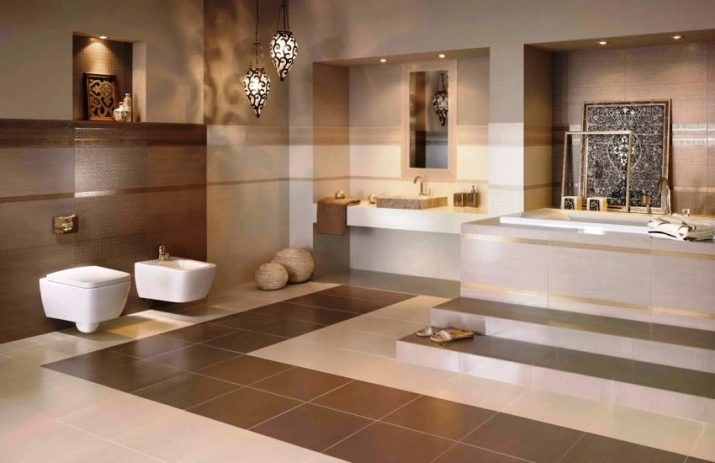
The classic interior looks noble, in which the walls and floor are finished with a material imitating marble.
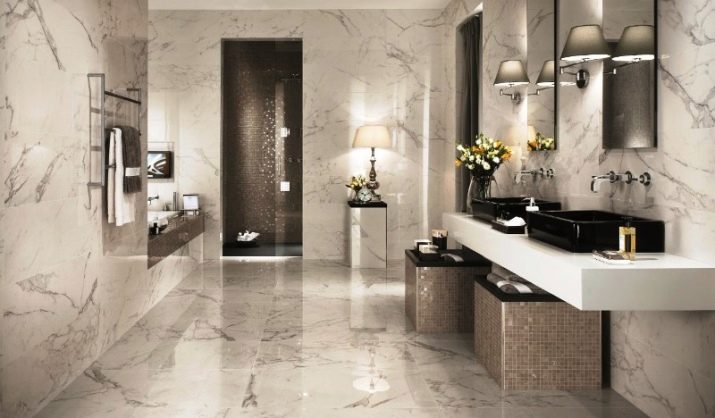
An unusual solution would be to use tiles that look like small stones.
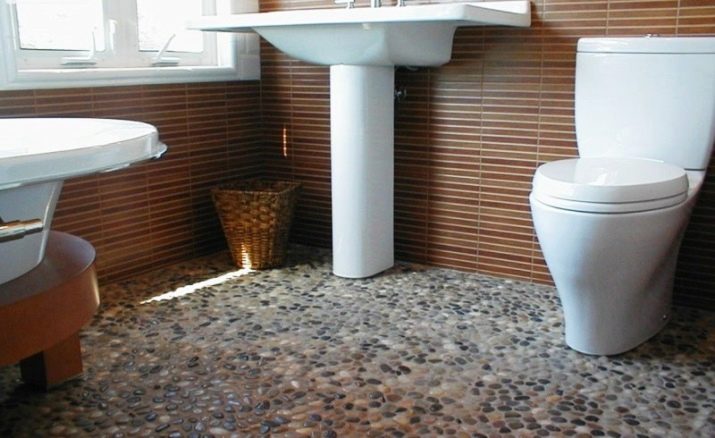
For information on how to properly lay the tiles on the bathroom floor, see the next video.








